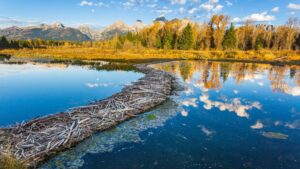Nice article this morning setting the record straight on beaver dams. Could we please all make sure that the New York Times and the San Francisco Chronicle and Phys,org and Discovery and Scientific American READ IT? Maybe post it on the refrigerator in the lunch room?
 Why do beavers build dams?
Why do beavers build dams?
And do the rodents live in these wooden structures?
Beavers are renowned for building dams, which the animals construct from trees and branches they cut using their strong front teeth, according to the National Park Service (opens in new tab). The rodents also use grass, rocks and mud to reinforce these structures.
But why do American beavers (Castor canadensis) build dams? Do they live in them?
Put simply, beavers build dams to stay safe, which is particularly challenging considering their awkward body shape and ungainly nature. “Beavers are 40-to-80-pound [18-to-36 kilogram] smelly bags of meat with really short legs,” Chris Jordan (opens in new tab), a fisheries biologist at the National Oceanic and Atmospheric Administration (NOAA)’s Northwest Fisheries Science Center in Newport, Oregon, told Live Science in an email.
Heyyyyy accuracy! Wow that’s different, I had no idea that was still possible. And wouldn’t you know it there isn’t ONE single nutria photo with this article! Hmm I’m guessing that paragraph about ‘safety’ means that a “ChickenMcnugget” metaphor is about to be delivered…Let’s watch…
That makes these large rodents easy prey. “When beavers are on the land, they’re very awkward and vulnerable, like great big chicken nuggets waddling around that any predator would be happy to have as a meal,” Emily Fairfax (opens in new tab), an ecohydrologist at California State University Channel Islands in Camarillo, California, told Live Science in an email. “But when they are in the water, they’re nearly invincible. They’re outstanding swimmers and can hold their breath for 10 to 15 minutes. By building a dam, they create a pond, and that pond is their safety zone.”
These bodies of water are deep enough for beavers to hide from predators, such as mountain lions, bears, wolves and coyotes, Jordan said. Damming can also flood areas to bring beavers closer to their main source of food, he noted. This includes the bark, leaves and twigs of trees, as well as aquatic plants, such as water lilies and cattails, according to a fact sheet from King County, Washington (opens in new tab).
And to protect the kits in the lodge by making it a swimmers only doorway. Don’t forget that part of the equation.
Furthermore, “beavers dig extensive canal networks behind their dams to spread the water,” Jordan said. This can safely bring them closer to trees, but it also helps “in transporting larger pieces of food and building materials back to their lodge, dam and food cache.”
Although dams protect beavers, they do not dwell within these structures. Instead, they often live in oven-shaped lodges made of sticks, grass, moss and mud built in or on the shore of the ponds their dams created, according to the University of Michigan’s Animal Diversity Web online database (opens in new tab). In these lodges, they reside in family groups, known as colonies, which are made up of five beavers, on average, the King County page says.
The Eurasian beaver (Castor fiber), which lives in Europe and Asia, is slightly larger than the American beaver. It also builds dams, lodges and canals, a 2020 study in  the European Journal of Wildlife Research (opens in new tab) noted
the European Journal of Wildlife Research (opens in new tab) noted
Oven shaped? That’s an odd metaphor. I can imagine the author is referring to dome-like shaped clay ovens in New Mexico but honestly that might not be what pops into the average readers mind when they see this article. I’m not really comfortable with the American people thinking beavers live in a Kitchenaid or Viking… I guess it’s better than saying they live in the dam. (But maybe it’s kind of like out of the frying pan and into the fire…Or out of the beaver dam and into the fryer?)
Beaver dams benefit not only their creators but many other species as well. “Beaver dams help slow water down and keep it on the landscape longer,” Fairfax said. “This transforms simple streams into thriving wetland ecosystems. The amount of food and water available in their wetlands makes them ideal habitat for many different species. That’s part of why beavers are what’s known as a keystone species.”
Ultimately, returning beavers to their original habitats may help reduce the impacts of climate change and benefit their ecosystems in many other ways, Fairfax and Jordan noted in an April 2022 perspectives piece in the journal WIREs Water (opens in new tab).
“When their dams slow water down, some of it gets stored in the soil, where plant roots can access it even during drought,” Fairfax said. “That helps keep vegetation lush, so that when wildfires start, the beaver complexes are uniquely resistant to burning. These fire-resistant patches help preserve intact ecosystems; provide refuge to animals that cannot outrun, fly or swim away from the fire; stabilize river banks post-fire; and help catch and settle out ash and sediment that is suspended in the streams post-fire.”
I just can’t ever get tired of that. That’s the message news organizations should be repeating over and over.
In addition, vegetation from beaver damming can draw the greenhouse gas carbon dioxide from the air and reduce flood damage, the scientists noted. When all this beaver-linked data was examined together, “it was remarkable how well-suited beavers are to not only survive changing climates, but also to accomplish some of the climate change adaptation work we as people have been trying to get done ourselves,” Fairfax said.
“My big takeaway from that is that we are not alone in our efforts to restore ecosystems and build resilience to climate change,” she said. “Beavers, and likely other ecosystem engineers and keystone species, are doing similar things through their own innate abilities. More progress will be made if we work with them rather than against them.”
Hooray! Let’s work with beavers and stop working against them! Let’s hasten along that CDFW toolkit and replace 150 depredation permits a year with flow devices and wrapping trees and installing culvert fences!
Let’s get this show on the road!







































